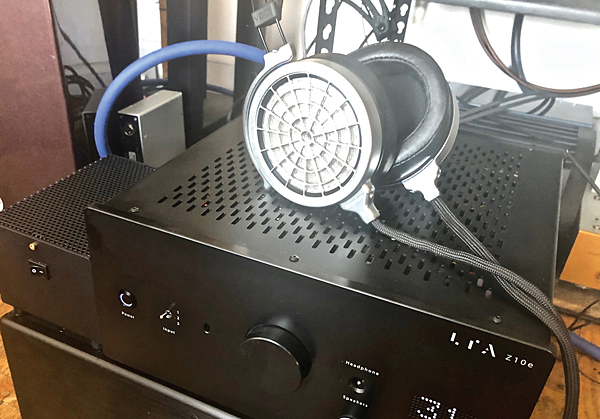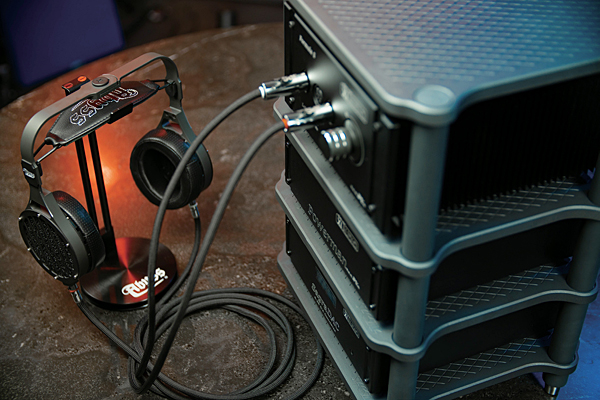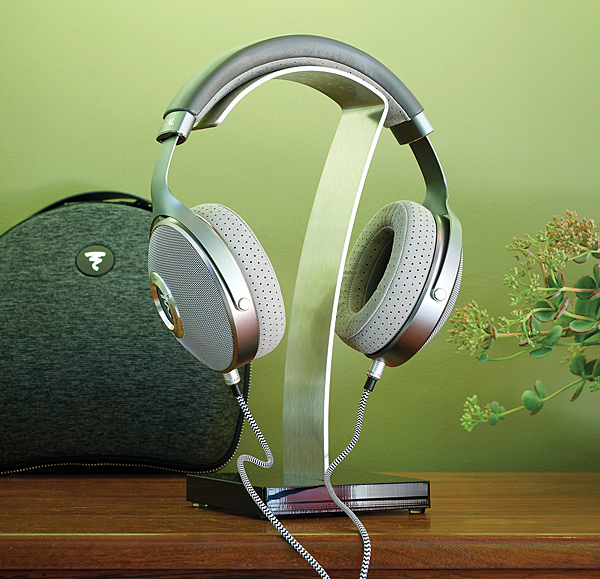| Columns Retired Columns & Blogs |
HR could also review the Linear Tube Audio ZOTL 40 reference amp (with measurements, please), $6,800 :-) ......
With the Stax SR-009S
Russian pianist Alexander Melnikov plays Debussy: Préludes du 2e Livre, La Mer (24/96 FLAC Harmonia Mundi/Qobuz) on his own Sébastien êrard piano, built in 1885, and it is like no Debussy I have heard. When I play this recording for my friends, they get uncomfortable because the tones emitted, especially from the piano's lower registers, are colorful and dense but very different, in a clanky sort of way, from smooth, modern pianos. This exquisite Harmonia Mundi recording showcases unusually vivid tones, delivered with scintillating transients and a grainless, easy-flowing viscosity. The LTA Z10e integrated amplifier driving Stax's $4325 SR-009S electrostatic headphones showed me more of Melnikov's quirky, nuanced fingerings, more of his eccentric pace and touch, more hammers hitting strings, more pedaling and soundboard sound, than any previous headphone amp–headphone combination (footnote 2). This combination of new-to-me amp and new-to-me headphone took these familiar Debussy works to a marvelous new place.

Striving is against my religion. However, when listening late at night, I do endeavor to stay locked on mentally to whatever performance I have chosen. On a good night, I can stay locked on for, at best, 180 seconds. With the SR-009S 'phones and Z10e amp, I listened to four complete tracks without once remembering where I was or what I was doing. Complete enthrallment. While listening to Melnikov, my ears and mind's eyes were in the microphones located about 30" from Alexander's piano strings. Everything I heard seemed extremely nuanced.
I repeat: extremely nuanced. When my consciousness finally slipped into audio-critical mode, I noticed: With the Z10e amplifier, the SR-009S headphones presented an unusually quiet (for electrostatics), highly textured, superbly resolved midrange; but to my shock and amazement the entire bass region (35–150Hz) had more weight and definition than I had previously experienced from a (non-S) Stax SR-009.
With the LTA amp, the new "S-type" Stax 009 created a tear-inducing, lightning-fast sound that kept me engrossed for record lengths of time. Best of all, this newfound bass response came with genuine boogie-factor. Even the subtlest musical rhythms had a distinct, engaging pulse. But, more than the good sound and rhythm-keeping, the SR-009S's displayed a unique insightfulness that showed me how the music was played.
With the Dan Clark Voce
Powered by LTA's Z10e, the $3299.99 Dan Clark Voce electrostatic headphones (footnote 3) sounded less like electrostatic headphones than the Stax SR-009S. The Voce 'phones presented Melnikov's piano music with a more analog feel than the SR-009S headphones. With the Z10e, the Voce headphones seemed more free, relaxed, and open than the Staxes. More large-scale dynamic and quieter, with blacker backgrounds. In fact, during my auditions, it was hard to remember the Dan Clark 'phones actually are electrostatics. Powered by the Z10e, the Voce 'phones sounded almost like the Abyss AB-1266 Phi TC planar-magnetic headphones. Almost.

The chief difference between the Voce electrostatics and my reference Abyss AB-1266 'phones was in the quality of space and detail—not the quantity. Both headphones have a refined, distilled essence to their sound. Both headphones make digital streams sound like magnetic recording tape (a good thing). The difference is, the Voce 'phones sound like ½" tape running at 15in/s while the Abyss 'phones sound like 1" tape running at 30in/s. (As the tape becomes wider and moves faster, the silence gets deeper and the treble more extended. Grain is reduced.)
With the HiFiMan Susvara
As usual, I start my (non-electrostatic) headphone amp tests with HiFiMan's Susvara planar magnetics (footnote 4). The Susvaras' 60 ohm impedance and lazy 83dB/mW sensitivity make them a difficult load. To play with their full descriptive energy, the Susvaras need at least 2 or 3 watts, maybe 300 milliamperes, and something like 7 volts. Headphone amps cringe when I plug them in. But with enough current and voltage gain, they're a contender for world's best headphones.
The Z10e specs describe a gain of 18dB gain into 8 ohms, but clearly it was not making 18dB into the headphone outputs. It did let the Susvaras play most of my difficult, bass-heavy program with reasonable clarity and élan. Unfortunately, there was zero punch, instrumental weight, or get-up-and-go energy. Clipping was noticeable especially on deep plucked or synthesized bass, where the Z10e would occasionally choke completely. I was disappointed by the Z10e's apparent lack of power, so I ran to the LTA website to see how much power they specified for the headphone outputs.
I could not find a listing for 50 or 300 ohms, so I wrote LTA's PR guy, Nicholas Tolson, asking for facts. He reported back: "Into 50 ohms the Z10e makes 500mW from the HI power output, and 77mW from the LO. Into 300 ohms, it can generate 220mW from the HI jack, and 19mW from the LO." Which is fine for most headphones, but not for one of the world's finest planar magnetics.
While I listened with the Susvaras, I kept shaking my head in disappointment: Why can't Linear Tube Audio give the headphone output the same power and gain it gives the speaker output?
With the Abyss AB-1266 Phi TC
The Abyss AB-1266 Phi TC headphones ($4995) are the most neutral-toned, transparent, lowest-distortion transducers I have ever encountered. With good recordings, the AB-1266s sound spooky real. The amazing part of the Abyss Phi TC 'phones is their complete absence of diaphragm breakup or modulation noise: They are the quietest speaker drivers I've ever heard. With the right amp, the AB-1266 'phones feel like they strip everything away between me and a recording.
Their 88dB/mW sensitivity makes them a little easier to drive than the Susvaras. Leastwise, they never choked or got dull. Through the Z10e's headphone jack, the Abyss-LTA combination played recordings in a manner that simply did not sound like audio reproduction. The AB-1266 Phi TC 'phones delivered purity and transparency to the source at a level that, if I'd never experienced it directly, I would never have imagined it existed.
I listened with the Abyss AB-1266 headphones to French tuba player Michael Godard playing an ancient valve-less snake-looking foghorn-sounding instrument called "the serpent," accompanied by a vocalist named Linda Bsiri and a pair of big resonating drums (from the CD Sous Les Voutes Le Serpent, M•A Recordings MA048A). Driven by the Z10e, the abject vividness of this 1998 Todd Garfinkle recording froze me in my seat, with my head shaking left-right in wonder. The space of the recording venue and instruments playing in it were presented with an uncanny unity. The AB-1266 headphones recovered recorded data in a way that seemed complete and fundamentally correct.
With the ZMF Vérité Closed
For a while, I thought I was experiencing this "how the music is played" phenomenon only on the Z10e's electrostatic output, but here it was again. Listening to jazz trumpeter Kenny Dorham's album Quiet Kenny (New Jazz/Electric Recording Company LP 8225), the Z10e's LO headphone output drove the 300 ohm (99dB/mW) ZMF Vérité closed-back headphones (footnote 5) in a manner that kept my attention focused on how Kenny was playing trumpet in the left channel, and how Art Taylor played drums in the right channel, and what Tommy Flanagan was doing on his piano in the center. Drums and cymbals sounded very much like I was in the room with them.
The ZMF Vérité 'phones played Quiet Kenny with a kind of For Duke (MK Realtime LP RT-101) direct-to-disc–quality realism. Every one of the 100 times I've heard the For Duke LP, I've been blown away by how solid and lively and tangible the instruments sound. The Z10e plus Vérité closed-back 'phones specialized in solid, lively, and tangible.
With the Focal Clear
I was not surprised when I discovered that the $1500 Focal Clears were the nonelectrostatic headphones the Z10e got on best with. The Clears' 55 ohm impedance, coupled to a 104dB/mW sensitivity, means that even iPhones like them. But iPhone amps can't make music magic like the Z10e did.

The Focal Clears are my #1 all-day, everyday headphones. I have used them with probably a dozen not-inexpensive amps, and none, not even the ZMF Pendant, excavated this quantity and quality of recorded information. The Clears/ Z10e combination dug unusually deep into the clock-workings of Alarm Will Sound's arrangement of Aphex Twin's "Blue Calx" (arr. C. Burhans) from their album Acoustica: Alarm Will Sound Performs Aphex Twin (16/44.1 FLAC Cantaloupe Music/Tidal). By "clock-workings" I mean the Z10e + Focal Clears effectively mapped the recording's manufactured space and filled said space with a quality of live energy that turned the entire Acoustica album into my new addiction. Think bass and space and high intelligence in demonstration-quality sound.
Please understand...
The point of this 36th chronicle of discovery is to direct your attention toward what might be Linear Tube Audio's finest achievement so far. LTA's Z10e integrated headphone and speaker amplifier is a uniquely conceived product that brings a kind of wabi-cha style of simple "artistic inclination" to the culture of headphone listening. I believe the Z10e shines a light on the path to the future of connoisseur-level audio. Why? Because it was artfully designed and crafted by creative people with an aesthetic vision and discriminating ears. The Z10e's purpose is to serve the newest breed of audiophiles: headphone devotees. People like me, who regard headphone listening as a kind of sacred solitude. People who appreciate the engineering beauty of full-range, low-distortion transducers. People who collect and cherish headphones for their ability to reveal what room speakers cannot.
Footnote 3: Dan Clark Audio: 3366 Kurtz St., San Diego, CA 92110. Tel: (619) 501-6313. Web: mrspeakers.com.
Footnote 4: HiFiMan, Head-Direct Corporation #2001, C1, 2F, Yingbin Road, Bacheng county, Kunshan City, Jiangsu Province 215300, China. Tel: (201) 443-4626. Web: HiFiMan.com.
Footnote 5: ZMF Audio, 3841 Ridgeland Ave., Berwyn, IL 60402. Web: zmfheadphones.com.

HR could also review the Linear Tube Audio ZOTL 40 reference amp (with measurements, please), $6,800 :-) ......

This is Nicholas from LTA. I am including below the manufacturer's comment we submitted that appears in the back of the print edition of this issue. This clears up the issue of the power of the regular headphone output.
--
[Note: this Manufacturer's Comment has been added to the main article as a sidebar]

For the price of Z10e, I wish it had a balanced headphone out. No matter what anybody says in terms of inherent single-ended design, no advantage of balanced, etc. All that may be true from the product engineer perspective. But, Single-Ended headphone cable is fundamentally wrong. Just who with the right mind will want to spend north of 10k (DAC, AMP, Headphone) and decided to short the return cable path? Would you ever do that with your speakers? Will you short the return cable of your speakers for any reason? Some of these headphones use just as much as electrical current as the efficient speakers. It's just an insanely fundamental design flaw. It does not matter an amp is SE or not, all the headphone out should switch to XLR type, just so it does not short the return path anymore. On average, there is over 20 dB difference in crosstalk alone when you stop shorting the cables. Your 6k amp may be perfectly engineered with SE design, but for the users - it's a very different story.

Like you Herb I really enjoy music through the LTA Z10e. I have owned mine for seven months now and it is a great component. It drives loudspeakers very well and the quality is maintained at high and low frequencies. As you say “I never thought I'd experience bass of that quality in my room—and from a 10Wpc OTL tube amp, no less!”
It is important to distinguish OTL from the circuit invented by David Berning which is ZOTL.
Most conventional attempts to eliminate the output transformer have the tubes driving the load directly. They have problems with low loads and need lots of tubes in parallel to do it.
David Berning’s invention matches the valve amplifier much better to the load with an impedance converter that emulates a near perfect transformer. It gets rid of the problems of the iron cored transformer and its windings. You have noted the audible results. I am struck by how efficient it seems as much of the power put in is converted to sound, and not too much heat.
It is so good that Mark Schneider and the LTA team are bringing this product to us.